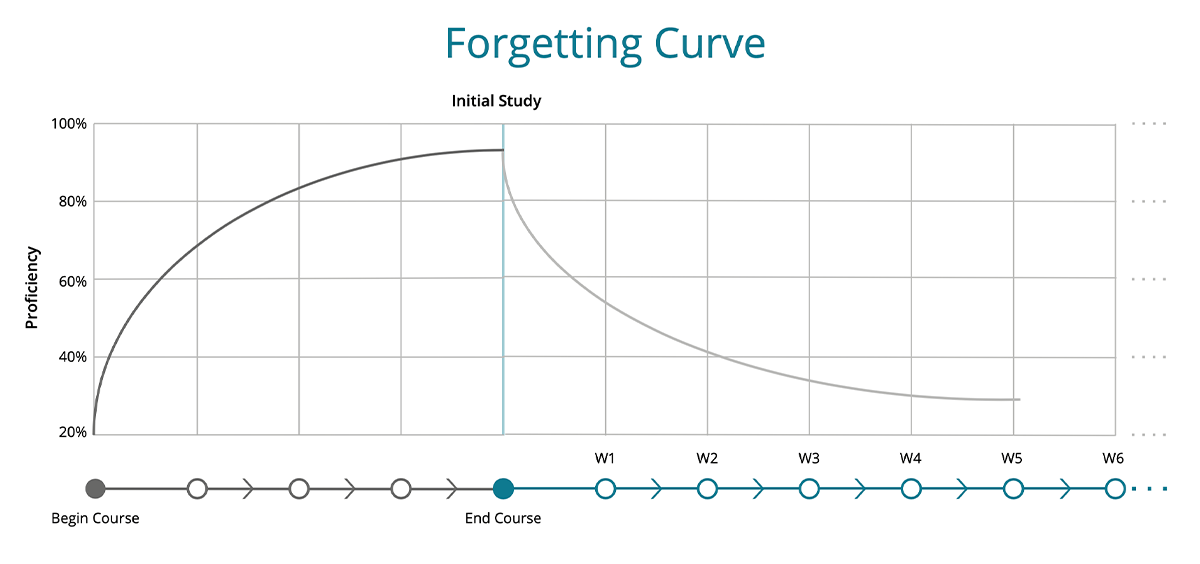Conquer the Forgetting Curve with Microlearning Strategies That Work
You know the drill. A learner is preparing for a big achievement -- let’s say passing an exam or earning a credential. This learner is in full-on study mode: they’re attending your online courses, reading books and articles, studying flashcards, and taking practice tests. The night before the test, they might even cram a little.
They pass the exam, and they earn the credential...but what happens next?
If your learner is like most people, they immediately begin to forget what they learned. After a month, they won’t remember much at all: it’s been shown that after just 30 days, learners forget 79% of what they learned.
In the learning science world, this memory loss is known as the forgetting curve, and it's a formidable enemy of high-stakes, high-impact learning organizations everywhere.
If you want your learning experiences to help learners achieve true mastery beyond the exam, you need a continuous learning strategy to combat the forgetting curve.
What does the forgetting curve mean for training and development?
The forgetting curve illustrates a fundamental fact about human memory — we don’t actually memorize. The human brain needs to use and retrieve information to commit it to memory. That means if learners don’t continuously apply new knowledge or review it, then they’re doomed to forget.

As you can see in this chart, learners build proficiency as they progress through their education. If the education is effective, by the end of their studies they are likely to pass the exam. And that’s when the forgetting curve kicks in.
The forgetting curve works against your goals for your learning programs because once learners complete an exam, they have little motivation to revisit their online courses. In fact, BenchPrep data shows that learners average 98% fewer sessions in an online learning platform after they complete their study plan.
For those of us who work in training and development, this reveals an ugly truth. When we focus all our learning programs on helping learners prepare for an exam, earn a credential, or complete a training, we’re not actually investing in their mastery.
Microlearning strategies are the future of professional development
In the modern world, education is becoming increasingly unbundled, which makes mastery an urgent priority. More and more learners are choosing to forgo traditional 4-year university studies in favor of associate's degrees, certifications, or bootcamps. Take a look at the IT industry, for example. In 2008, just 38% of IT professionals held at least one certification. In 2019, 85% are certified.
Education designed to help a learner pass a test or earn a credential is an important first step on the path to mastery. The learning organizations who recognize this first step and build a strategy to keep learners engaged on an ongoing basis are the ones who will succeed in the long run.
This is all to say that if your organization hasn’t invested in continuous learning or microlearning strategies, now is the time to start.
The healthiest training and development companies are future-proofing their strategies by coupling standard online courses with microlearning. The education that comes before an exam or during a training session helps learners build, practice, and prove their knowledge. The microlearning that comes afterward helps them continuously apply their knowledge and achieve true mastery.
An effective microlearning strategy also uses spaced repetition and confidence-based learning to keep people engaged.
The BenchPrep Approach
We launched our newest product, BenchPrep Engage, to help learning organizations solve their forgetting curve-related problems. Through regularly-spaced microlearning cycles, BenchPrep Engage interrupts the forgetting curve to give your existing training programs a boost, extend your learner relationships, and help your learners achieve better outcomes.
These microlearning cycles increase learner engagement and help your learners achieve mastery, which ultimately makes them more effective at their jobs. That, in turn, makes your learning programs more valuable.
Continuous learning is the right thing to do by your learners if you want to help them achieve mastery, and it’s also the right thing to do to make your learning business more profitable in the long run.
To learn more about the relationship between continued learning strategies and building sustainable revenue streams, download our newest e-book, Dreaming of Recurring Revenue? Engage Learners Continuously.






